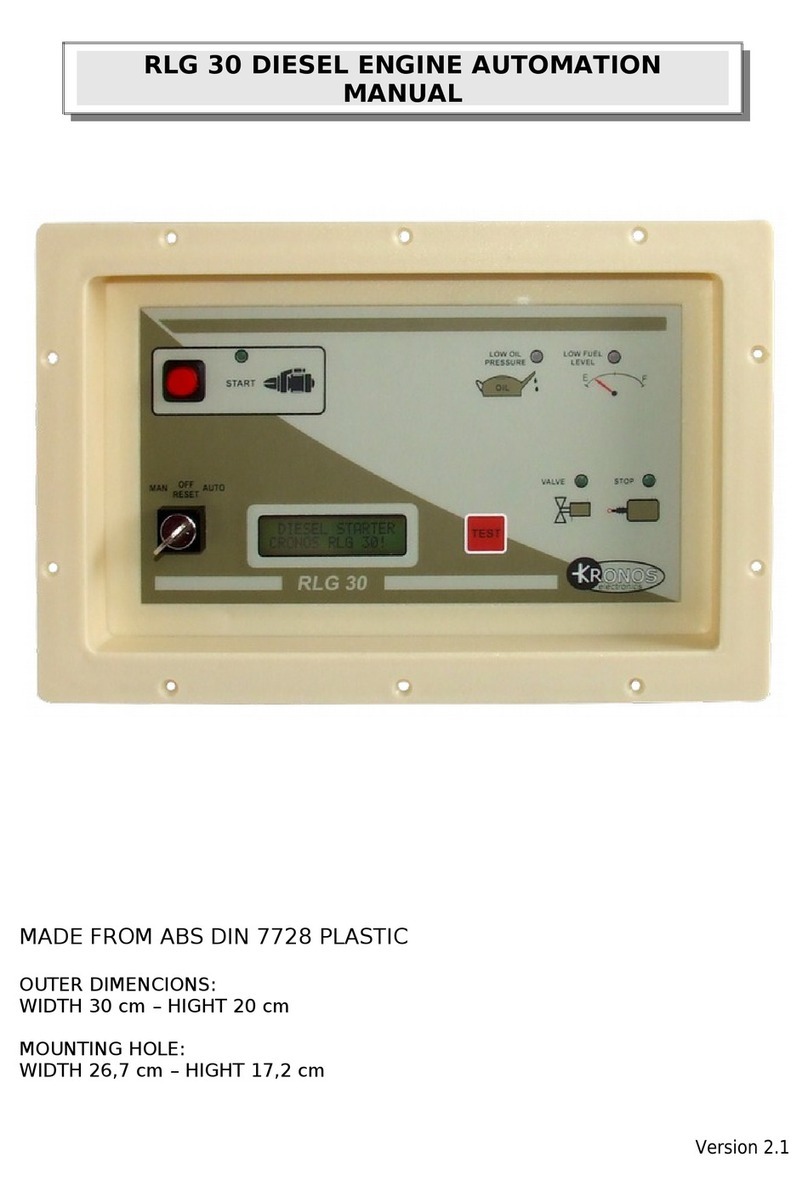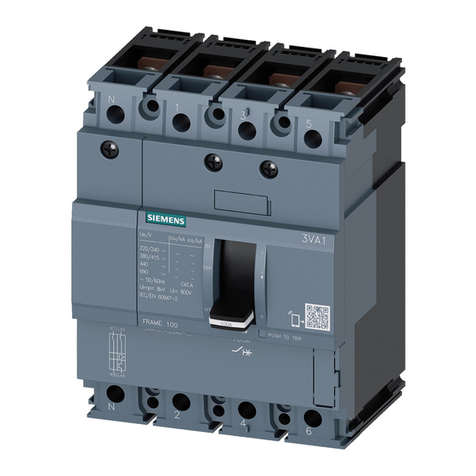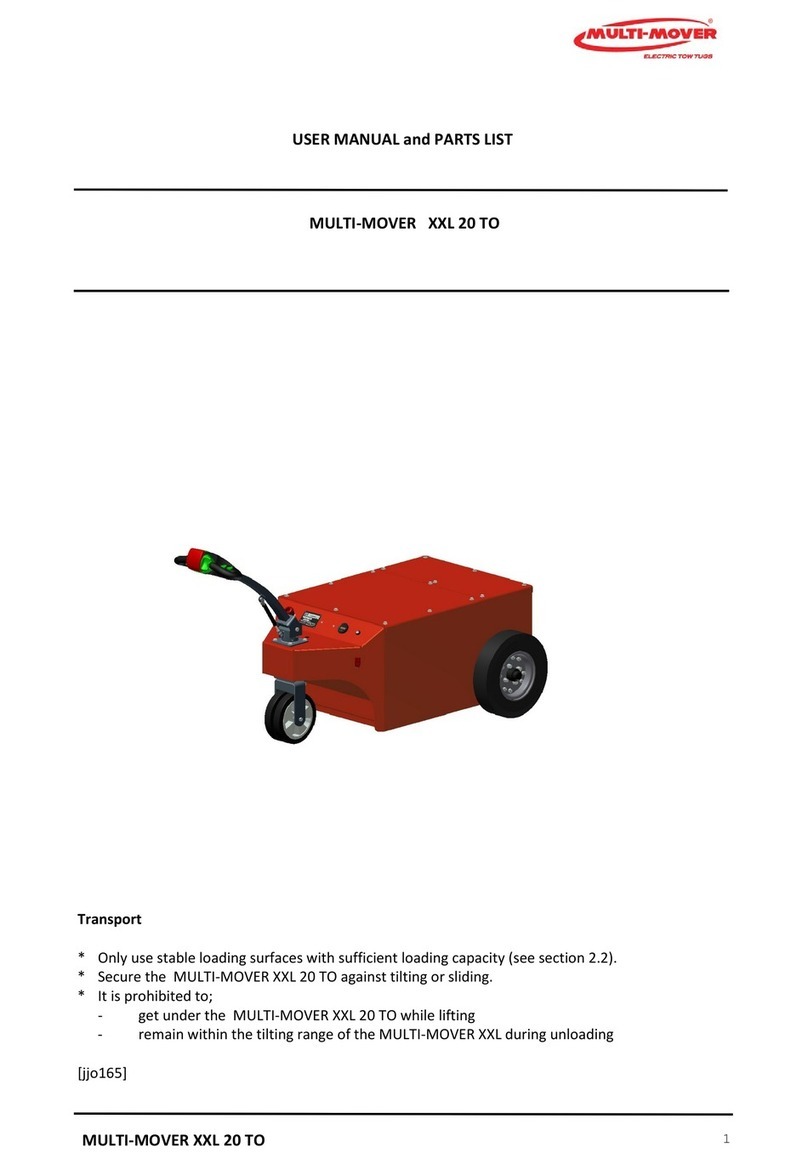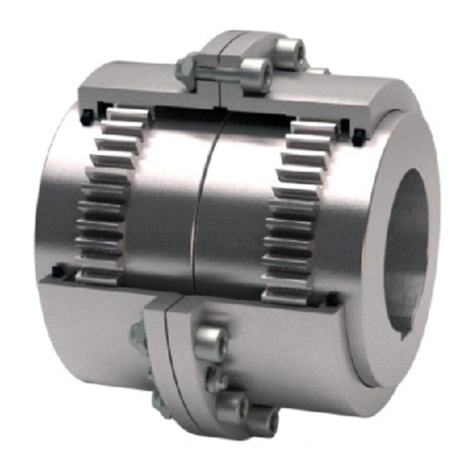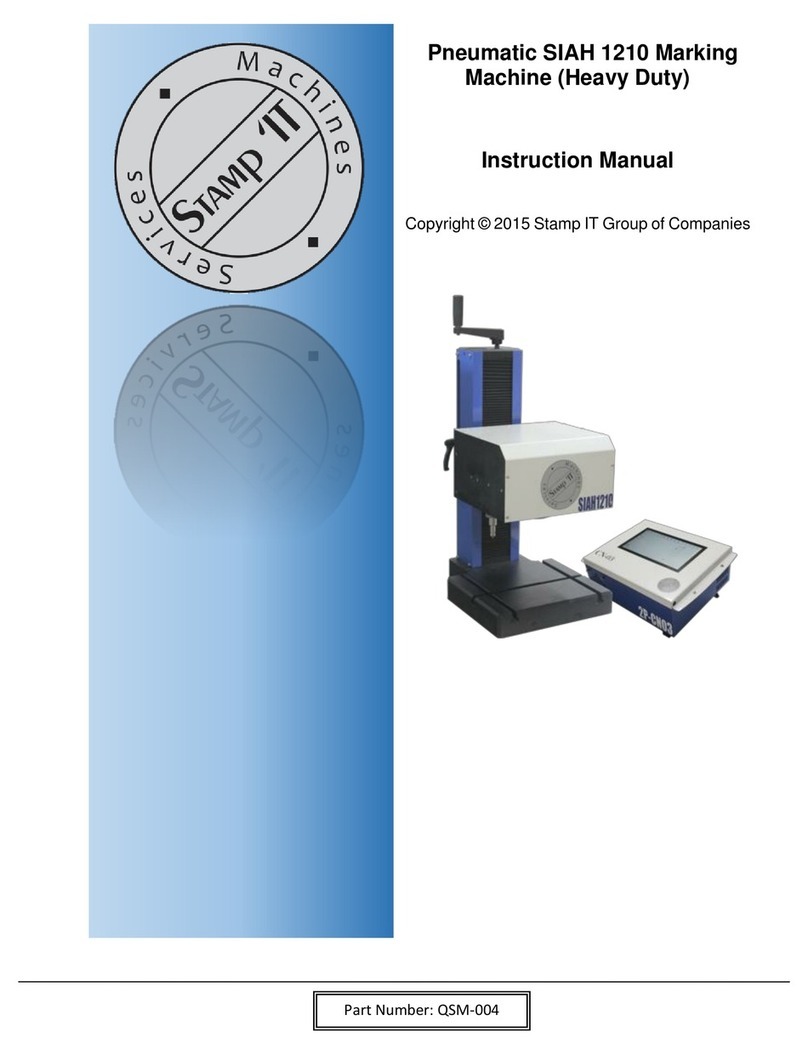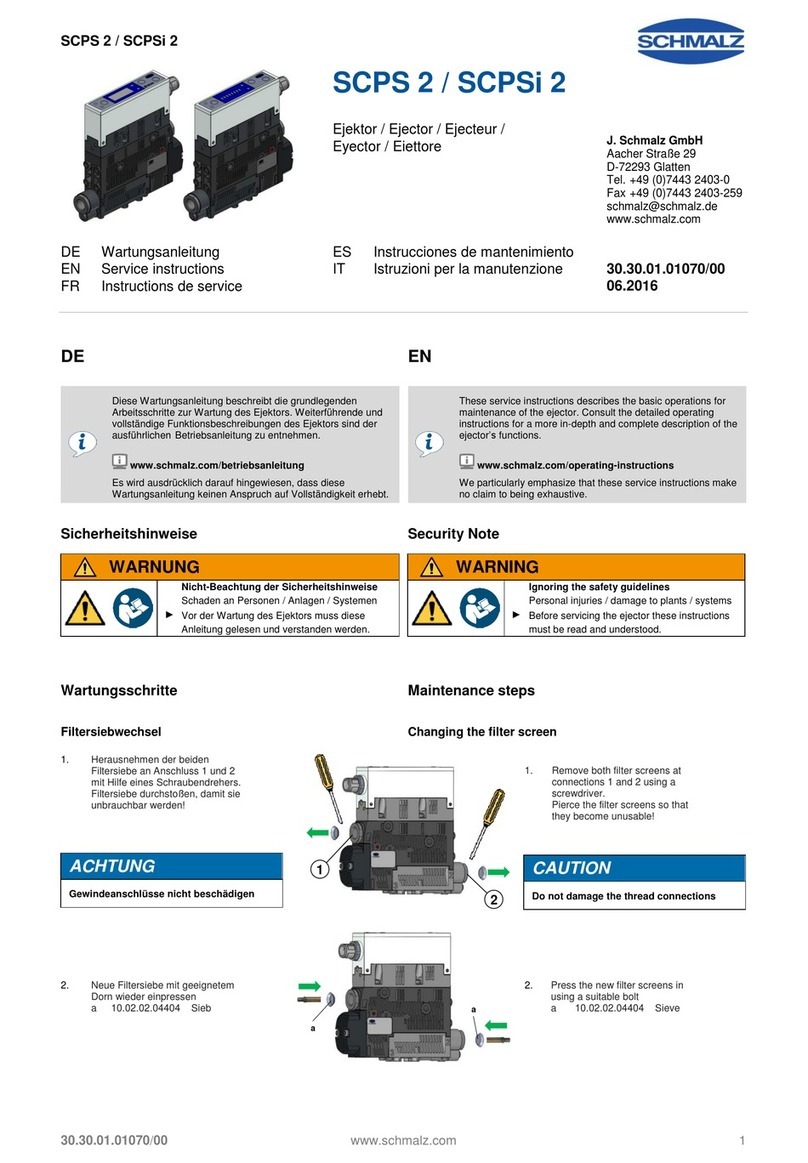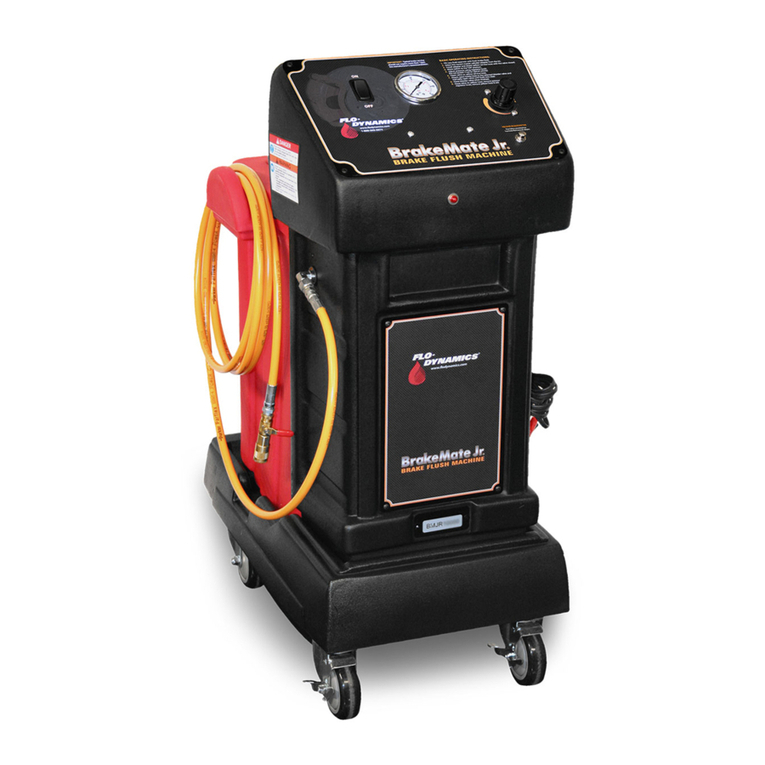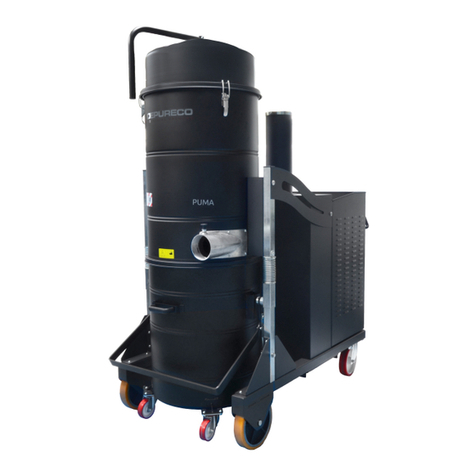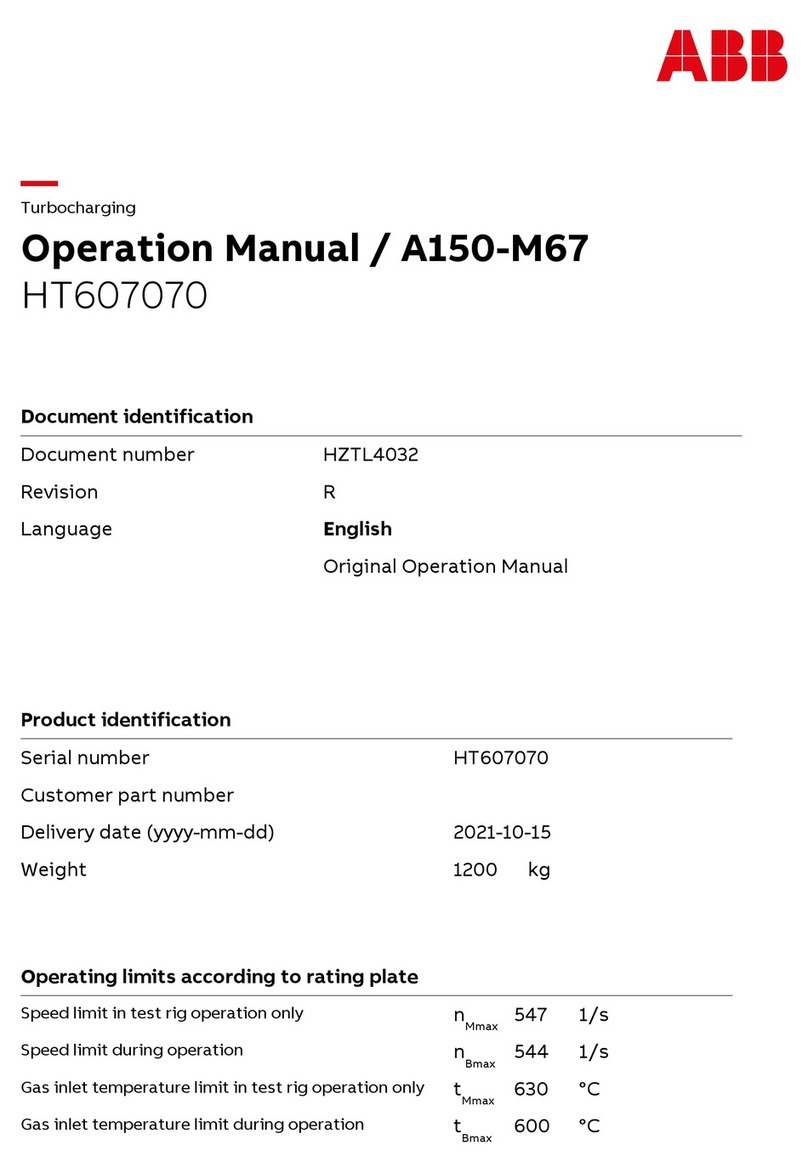Kronos KARGO 121 User manual

www.kronos.
BRUKSANVISNING • KÄYTTÖOHJEET • USER MANUAL
USER MANUAL
KGO 121

INDEX
Wikarsvägen 12, 68500 Kronoby, FINLAND I mail@kronos. I www.kronos.© WIKAR OY AB
USER MANUAL: KARGO 121
GENERAL
Use of manual 3
Summary of safety instructions 3
CONSTRUCTION
Principal parts forest trailer and optional equipment 4
Type plate of trailer 4
TECHNICAL SPECIFICATIONS
Technical specifications 5
USE OF TRAILER
Connecting trailer to tractor 6
Loading of trailer 7
Drawbar steering 7
Pneumatic brake 8
Hand brake 8
Working at low temperatures 8
OPTIONAL EQUIPMENT
Crane base and support legs 9
Toolbox 9
Frame extension 11
Smart Drive 12
Bogie with hydraulic hub drive 12
Smart Drive+ 13
Setting drive speed 13
Pump equipment 16
MAINTENANCE
Safety instructions for maintenance 17
Maintenance table 17
Lubrication points 18
Basic instructions for maintenance 18
Storage of trailer 18
Disposal of obsolete trailer 19
WARRANTY
Warranty terms 20
Warranty repairs 20
Warranty application 21
Notes 22

GENERAL
USE OF THE MANUAL
This manual is intended for support and guidance to a buyer of KRONOS 121 forest trailer and is supplied with
the trailer. On the following pages we try to provide as complete information as possible on the correct handling
and maintenance of the trailer. We urge you to familiarise yourself with this information before taking the trailer
into use, because it lays the foundation for safe and efficient use of the forest trailer. Keep the manual in a place
where you will find it in the future whenever needed.
This manual guides you with the normal servicing and maintenance measures. Perform the servicing measures
according to the regular maintenance programme found in the manual and make daily servicing a routine for
yourself. All this is for the best of both you and your forest trailer. Remember that the maintenance costs are
usually very low compared to the repair costs of defects arising from neglect.
This manual uses pictorial symbols for easier reading. Their content is as follows:
Safety instruction. The instruction must be complied with to avoid personal injury.
Instruction: The instruction shall be complied with to avoid breakdown of parts.
Note: This will teach you how to proceed and avoid mistakes.
SUMMARY OF SAFETY INSTRUCTIONS
• Read the instructions on installation and use of the trailer before using it.
• Ensure the tightness of the wheel bolts after the first 8 hours of use and regularly thereafter.
• Make sure that the crane is attached to the trailer as planned.
• Keep in mind the laws and regulations concerning road traffic.
• Keep in mind the laws and regulations concerning loading work.
• Use only original spare parts.
•Follow the maintenance programme presented in the manual.
•Remember to warm up the hydraulic system in cold conditions. Check the tightness of the hydraulic system
regularly. Do not spill any oil in nature.
•Fix even small defects as soon as they emerge before they cause more serious damage.
•Do not use the forest trailer for carrying people.
•Use driving lights and a slow-moving vehicle sign when driving on a public road.
•Be particularly careful when there are people or animals near the working area.
•Always work calmly and with consideration.
•Use drawbar steering with consideration – risk of falling over.
•Look after the condition of the drawbar steering hoses. A cut or damaged leaking hose will result in loss
of control of drawbar steering – risk of falling over.
•Always lock the drawbar mechanically with the locking bolt when driving on a public road.
•Do not overload the trailer. (Carrying capacity is stated in technical specifications)
•Do not pile the load higher than the front grill, as the logs may be pushed forward in case of sudden braking.
•Make sure that the forest trailer is parked on a flat surface so that it cannot move while performing mainten-
ance or installation. If necessary, support the trailer in place with wedges in front of and behind the wheels.
– 3 –

CONSTRUCTION
PRINCIPAL PARTS / OPTIONAL EQUIPMENT OF FOREST TRAILER
1. Frame Optional equipment
2. Drawbar 7. Hydraulic front grill
3. Wheel 8. Crane base and support legs
4. Bogie 9. Toolbox
5. Rear light beam 10. Frame extension
6. Movable bank 11. Hydraulic hub drive (4 WD / 2 WD) / wheel drive
7. Front grill 12. Hydraulic pump equipment
13. Back camera and working lights
TYPE PLATE OF TRAILER
The type plate of the trailer can be found on the front
right-hand side corner of the trailer frame. In case the
type plate becomes damaged or gets lost, copy the details.
– 4 –

TECHNICAL SPECIFICATIONS
TECHNICAL SPECIFICATIONS
All rights reserved.
– 5 –
(*) Version LONG
Grill and banks can be installed
freely with 150 mm spacing.
Place of grill without
the crane base
Axle weight, kg 12 000
Weight without optional equipment, kg 2 500
Drawbar weight max, kg 3 000
Load area cross-section, m² 3,1
Turning angle of drawbar, degrees 35
Bogie movement range, degrees 20
Tyre pressure (bar) Alliance328 550/45 22,5” 2,6
Tyre pressure (bar) Alliance328 600/50 22,5” 2,8
Tyre pressure (bar) Nokia TRS 600/50 22,5” 5,0

USE OGF TRAILER
CONNECTING TRAILER TO TRACTOR
• Connect the trailer to the tractor’s draw hook and lift the parking leg to up position.
• Couple the hydraulic system connectors, the hoses are labelled at the factory. The coupling requires
the following hydraulic blocks:
– One double-action block for drawbar steering
– One single-action block for roll drive (continuous flow)
– One double-action block for hydraulic moving of the grill
• If the trailer is equipped with LS hydraulic valve, connect the LS-line, drain, pressure and return
according to the tractor manual.
• Connect the trailer light plug to the tractor’s coupling.
• Attach possible roll drive control box inside the tractor cabin.
• Connect the hoses for hydrulic och pneumatic brakes according to the tractor manual.
• Test all functions first easily, so that any air in the hydraulic system can get out. Check that there are
no leaks in the hoses or couplings.
• Check the operating of brakes and lights before driving on a public road.
– 6 –

USE OF TRAILER
SÅ LASTAR DU SKOGSVAGNEN
Follow the instructions below when loading timber:
• Lift the first logs of the load carefully. The stability of the trailer improves when the load increases
somewhat. Use the support legs if required.
• The length of the timber to be loaded affects essentially the centre of gravity of the load. If required,
move the front grill so that the centre of gravity of the load is as close as possible to the bogie tipping
centre. Then the vertical hook load to the tractor will not increase unnecessarily.
DRAWBAR STEERING
• Always use drawbar steering calmly and with consideration. Too fast movements in drawbar steering may
cause danger situations and falling over of the trailer.
• When driving on the road, turn the drawbar to point straight ahead and lock it mechanically with the locking
bolt. Remember to release the locking bolt for off-road driving.
– 7 –
Optimal centre of gravity of load
Drawbar locked
Drawbar released

USE OF TRAILER
PNEUMATIC BRAKES
When the trailer is equipped with pneumatic brakes, the braking force can be adjusted according to the loading
situation (full load, half load and empty cargo space). The brake power is adjusted with a separate brake force
regulator by turning the lever to the desired position in valve no. 1. The trailer can be moved without compressed
air connected to the trailer by releasing the brakes with button no. 2. When the button is pressed fully, the brakes
are released, and when the button is pulled back, the brakes are engaged again – as long as there is enough pres-
sure in the tank. The compressed air tank should be regularly emptied of accumulated condensed water, which
is done with the drain valve at the bottom of the tank.
Adjusting the brakes
When the brakes are worn it is advisable to adjust the brakes. The brakes are adjusted from the brake lever
inside the bogie bar using the adjustment screw indicated by the arrow (in the picture above).
HANDBRAKE
• Always use the handbrake when you
disconnect the trailer from the tractor.
• Rotate the handbrake knob with the crank
clockwise to activate the handbrake and
anti-clockwise to release the handbrake.
WORKING AT LOW TEMPERATURES
When the temperature falls below 0 C, it is recommended to warm up the hydraulic system before use. First let
the oil circulate freely for a while in the hydraulic system between the oil tank and the control valve and then
perform the first moves carefully, so that the seals of the cylinders and valves get soft. Then you can start normal
work.
• Working at the temperature of below –25²C is not recommended. At low temperatures the seals and
hoses wear out faster.
– 8 –
Adjusting the brakes

OPTIONAL EQIUPMENT
CRANE BASE AND SUPPORT LEGS
• In choosing the crane, special attention shall be paid to the suitable size of the crane.
• The highest permitted lifting moment of the installed crane is 75 kNm.
• The recommended cranes are KRONOS GRIPTO 608, 609, 708, 709.
• If you are uncertain about the suitability of the crane you have chosen, you can contact the factory.
• Too big a crane can damage the structure of both the trailer and the base.
• Too small a crane cannot necessarily reach over the front grill to make work flow smoothly.
• Always follow the installation instructions of the crane when installing it.
All rights reserved.
TOOLBOX
Lockable toolbox can be installed on either side of the trailer.
The toolbox can also be installed afterwards, as there is a place for toolboxes in the frame.
– 9 –

OPTIONAL EQIUPMENT
SSC – SMART STABILIZER CONTROL, SUPPORT LEG AUTOMATION
SSC is an additional function of the xCrane steering system. This function allows you to raise or lower the support
legs semi-automatically. Three quick pushes of a button for support leg activation lower both legs until both of
them touch the ground. The legs are then fine-adjusted until the right pressure is achieved.
Two quick pushes of a button raise both support legs to the up position. The automatic movement is interrupted
immediately, if you push the support leg button or move the joysticks. SSC can also be activated if the crane is
not active, e.g. when the seat is swung forward and you start loading or when the seat swings forward from back
position once the loading is finished. Support legs can always be controlled manually by holding the support leg
button pushed while the left/right lever is moved forward or backward. Automation upward or downward can also
be activated even though the support legs are somewhere between the up and down positions.
It is not permitted to activate the automation downward if one of the support legs is closer than 500 mm from
the ground. The reason is that then the automation will not necessarily function optimally and as a result the
trailer may fall over. Remember that the operator is always responsible for the machine and shall see to it that
it is safe around it.
The operator can adjust the pressure/strength with which the support legs are pressed to the ground. See to it
that the support legs are in the up position before you start the adjustment. Go to xCrane display under Diag-
nostics. Then choose Sensors and move with arrow keys until you see the following menu on TDC’s Opus display:
– 10 –

OPTIONAL EQIUPMENT
SSC Pressure limit (Stabilizer pressure limit on TDC display) shows the current pressure level. If you want to
adjust the pressure by which the support legs are pressed down, press Adjust. The colour of the button will
change and look as follows:
Press three times in normal order to lower the support legs. When they touch the ground, the pressure will slowly
rise in the left and right support leg. When the right pressure level has been achieved, press the support leg but-
ton once. The new pressure is shown lowermost. If you are not satisfied with the new value, you can repeat the
process by raising the legs and then lowering them again automatically and finish the process again by pressing
the support leg button at the desired pressure level. If you are satisfied with the value, press Adjust and use the
arrows to return to the basic menu. The xCrane asks whether you want to save changes. Only after you confirm
by pressing Yes the new pressure value is used. Note that a pressure value that is close to the maximum pump
pressure can cause problems with functioning when the hydraulic oil is cold. Hence you should leave a safety
margin of at least 10 bar under the maximum pump pressure.
FRAME EXTENSION
Frame extension lengthens the load area by 290–940 mm.
A support plate above the frame shall always be placed to support the attachment screws of the frame extension.
Separate support plates shown in Figure A are included. If you want to install the bank in place of attachment
screws, it will also act as support plate (Figure B).
– 11 –

OPTIONAL EQIUPMENT
SMART DRIVE
The forward/backward function is activated using either the lever switch in the control box or the xCrane control
panel, if xCrane is delivered together with the trailer. If xCrane is also connected to a Valtra tractor, the Smart
Drive feature is available.
Smart Drive is Kronos’ automatic drive control system. It means that the drive is connected on and off automa-
tically and in the right direction. That is based on the speed and direction data from the tractor’s CAN bus. The
device has a safety function that deactivates the trailer drive at speed of over 10 km/h, but depending on the
tractor’s oil flow, cavitation usually takes place already before that in hydraulic motors. That’s why the function
shall always be switched off when the tractor speed is higher than the driving speed of the trailer. It is also pos-
sible to activate the function manually, but not in the opposite direction from the tractor.
BOGIE WITH HYDRAULIC HUB DRIVE
The trailer can be equipped with either two or four hub motors
Hub motor = BlackBruin B250
Hub drive
Kronos trailers can be equipped with either two or four hub motors to achieve better drive. By choosing hub
motors you will enable the use of chain and rollers, which is not possible with roll drive. When the drive is not
switched on, the hubs rotate free of the motor: “Free-Wheeling”. Then the motor does not create resistance and
heat the oil. Even if the drive were not switched on, the hydraulic hoses shall be connected to the tractor whene-
ver the trailer is moved. The control valve of the motors has a flow balancing function that generates a similar
effect as the lock of differential gear. It is possible to choose three different power levels for the drive with the
3-position switch. Do not choose a higher power level for the drive than the tyres can grip. A green light is lit at
the lowest power level, a yellow light at medium level, and a red light at the highest level. When the light plug of
the trailer is connected, the lowest power level is automatically switched on when braking.
Smart Drive on / off
Drive forward / backward
4 WD 2 WD
– 12 –

OPTIONAL EQIUPMENT
In a trailer equipped with four hub motors the control panel has a switch for choosing 2WD or 4WD. Always use
2WD if there is not enough oil for all four hub motors. When using 2WD the top speed is doubled and the power is
halved. The front wheels of the bogie drive actively when the trailer has two hub motors.
SMART DRIVE+
It is also possible to connect Smart Drive+ function to hub drive. In addition to automatic drive, synchronised
drive function can also be used. It means that the motors drive the trailer at the same speed as the tractor. 3-po-
sition switch is used to choose different drive speeds compared to the tractor speed. The driving speed forward
is around 10% faster (boost). That state is intended for wet off-road conditions. In the middle position the speed
is normal. The trailer drives backwards a little more slowly than the tractor. That state is suited to steep turns.
The drive function will be automatically deactivated when braking. The trailer is equipped with a pressure sensor
that deactivates the function, if the flow from the pump is not enough, i.e. if the pressure is not sufficient for the
motors. The feature prevents harmful cavitation of the motors. When that happens, the tractor has to be stopped
to reactivate the function.
SETTING THE DRIVE SPEED
A hub drive trailer with Smart Drive+ function is delivered with a speed curve pre-set for the motors. That curve
may need to be adjusted before using the trailer. Reasons for that include e.g. manufacturing tolerance of com-
ponents, deviations between the real tractor speed and meter reading, and delta P pressure of the pump. Thus
the trailer may drive either too fast or too slowly. The setting can be done in two different ways. It is possible to
drive on a flat surface and follow visually how fast the wheels turn when starting from 0 km/h and increasing the
speed slowly to 7 km/h (2WD). The other way is to monitor the motor pressure at different speeds.
Choosing power level
2WD/4WD
On/Off
On/Off
Slow / Normal / Fast
– 13 –
Control box without xCrane

OPTIONAL EQIUPMENT
The motor pressure can be checked in the xCrane display from the Diagnostics and Sensors menu.
Traction M1 A pressure =pressure forward left-hand side (VALVE 7)
Traction M1 B pressure = pressure backward left-hand side (VALVE 7)
Traction M2 A pressure = pressure forward right-hand side (VALVE 8)
Traction M1 B pressure = pressure backward right-hand side (VALVE 8)
The driving speed of the trailer is synchronised by increasing or decreasing the control flow to the directional
control valve of the motors. The setting is done as follows:
• Set the speed switch to Normal position
• Choose “Settings” in the xCrane control panel
• Go to “Maximum speed” menu and the second tab VALVE 7 and VALVE 8.
• Increase the percentage if the trailer drives too slowly and decrease it if the trailer drives too fast.
• Press e.g. VALVE 7 to set the value to the left, the upper value is gate A forward and the lower is gate
B backward.
• Choose “Menu” and then “Diagnostics and Sensors”.
• Check that the pressure is even in both the left-hand side and right-hand side motors at different
speeds when driving forward. Readjust as needed.
• Do the same test for driving backward.
– 14 –

OPTIONAL EQIUPMENT
The “Minimum speed” function affects the trailer drive at low speed. This value has to be around 620 mA and
usually it need not be adjusted. If you cannot make the trailer drive evenly to left/right or forward/backward at
low speed, the value can be adjusted by a maximum of 20 mA up or down. This is done as follows:
• Set the speed switch to Normal position
• Choose “Settings” and then “Minimum speed”.
• Choose the second tab by pressing the left arrow.
• Press e.g. VALVE 7 to set the value to the left, the upper value is gate A forward and the lower is
gate B backward.
• Choose “Menu” and then “Diagnostics and Sensors”.
• Check that the pressure is even in both the left-hand side and right-hand side motors at different
speeds when driving forward. Readjust as needed.
• Do the same test for driving backward.
• Higher maximum speed increases the
speed compared to tractor.
• Lower maximum speed decreases the speed
compared to tractor.
• Higher minimum speed increases the speed
compared to tractor at low speed.
• Lower minimum speed decreases the speed
compared to tractor at low speed.
– 15 –

OPTIONAL EQIUPMENT
PUMP EQUIPMENT
Hydraulic pump is installed inside the crane base, and the oil tank will be placed on the right-hand side of the
trailer.
Pump = Bosch Rexroth 71 cm3/r
Step-up gear = PeuralaHP9
Step-up gear oil = SAE 80-90, 1,8 liter
Oil tank = Total volume 115 litres, thickness 8 mm
Maximum speed for the pump equipment is 1000 rpm.
– 16 –

MAINTENANCE
SAFETY INSTRUCTIONS FOR MAINTENANCE
Always comply with the following instructions in maintenance of trailer:
• Make sure that the tractor is switched off and the key is not in the ignition.
• Make sure that the trailer stays in place. Switch on the parking brake of the tractor and support the
trailer in place with wedges if necessary.
• Do not let children or any other outside person enter the tractor cabin during maintenance.
• When you disconnect the hydraulic hoses, make sure that the line in question is unpressurised.
• Be careful otherwise and do not rush. Think before you act.
• Avoid skin contact with oil and grease. Wear appropriate protective clothing and gloves.
• Seek medical assistance, if you notice changes on your skin caused by hydraulic oil or lubricants.
MAINTENANCE TABLE
Note! ( ) First time
* Daily
Use only high-quality lubricant, such as MOBIL GREASE SPECIAL eller SHELL RETINAX AM.
Object of
maintenance
Action Maintenance
interval / h
NB!
General Check that there are no leaks. 10 *
Check the pins and locking. 50
Check hose couplings. 50
Tighten the locking bolts of wheels. 50 (8) 550 Nm
Cleaning and superficial inspection of structures. 250 Whenever needed
Lubrication Lubrication of drawbar bearings with a grease gun. 10 * 2 nipples
Lubrication of bogie bearings with a grease gun. 2 nipples
Lubrication of articulation bearings of rotary actuators
with a grease gun.
4 nipples
Lubrication of support leg cylinders with a grease gun.
– 17 –

LUBRICATION POINTS
BASIC GUIDELINES FOR MAINTENANCE
• Thorough and on-time maintenance allows for functioning and durability of your trailer for a long time.
• Add a small dose of lubricant often rather than a large dose rarely.
• Remember that the purity of lubricant is very important.
• Try to repair any defects as soon as possible to avoid more significant damage.
STORAGE OF THE TRAILER
If the trailer is disconnected from the tractor for storage for a longer period, the following measures should
be taken:
• Clean the trailer thoroughly and check the structures. Repair any defects and deficiencies immediately.
• Touch-up painting is recommended for areas where the paint has worn out or been chipped off.
• Grease all joints and lubricate the cylinder shafts with Vaseline. Perform the lubrication immediately after
cleaning.
• Check the air pressure in the tyres.
• If possible, place the trailer under a roof. If you have to place the trailer under the open sky, however, see to it
that the electric couplings and components will not get wet.
• Leave the trailer on a flat surface and see to it that the support leg will not sink in the ground.
MAINTENANCE
– 18 –

MAINTENANCE
DISPOSAL OF THE TRAILER
When the lifetime of the trailer comes to an end, it shall be disposed of appropriately in compliance
with all environmental laws and regulations that concern the disposal of waste and scrap.
Comply with the following instructions:
• Deliver the equipment to be scrapped to a waste disposal company where professionals will
disassemble the equipment and sort the parts. If you are unable to deliver the equipment to waste
disposal, you can do the following:
1. Drain the oil from the hydraulic system and take the waste oil to a collection point.
2. Detach all modules from each other.
3. Gather the hydraulic hoses and tyres and take them to waste rubber collection point.
4. Take the metal parts to scrap metal collection.
– 19 –

WARRANTY
WARRANTY TERMS
• We grant a 12-month or a maximum of 1,000 working hours warranty for material and manufacturing defects.
• The warranty takes effect on the date of delivery, when the warranty card must be completed and returned
to the factory.
• The warranty covers manufacturing and raw material defects, excluding hydraulic hoses with their
connectors or hydraulic seals.
• The warranty does not cover defects caused by normal wear and tear, faulty installation, lack of maintenance,
or improper use.
• The warranty does not cover consequential effects of possible damage.
• The warranty shall lapse, if the equipment has been repaired by a party other than the manufacturer or
a repair shop authorised by the manufacturer, or if the pre-set pressure areas of the equipment have been
changed.
WARRANTY REPAIRS
• The service networks of dealers carry out warranty repairs, but simple repairs, such as replacing a part, may
be done by the customer. In such cases we just supply the new part, for the delivery of which the warranty
application form shall be completed.
• In extremely urgent cases other procedures may be applied, if the matter has been agreed on with the dealer
or the factory. If the repair is carried out by a party other than an authorised service person, a prior agreement
must be made. In that case, the name of the person with whom the agreement has been made must be given
in the invoice or warranty application. If this is not done, the warranty application shall not be not be
processed and no compensation shall be paid.
• Enclosed a sample warranty application form which shall be completed if necessary.
Wikarsvägen 12, 68500 Kronoby, FINLAND I mail@kronos. I www.kronos.© WIKAR OY AB
Table of contents
Other Kronos Industrial Equipment manuals
Popular Industrial Equipment manuals by other brands
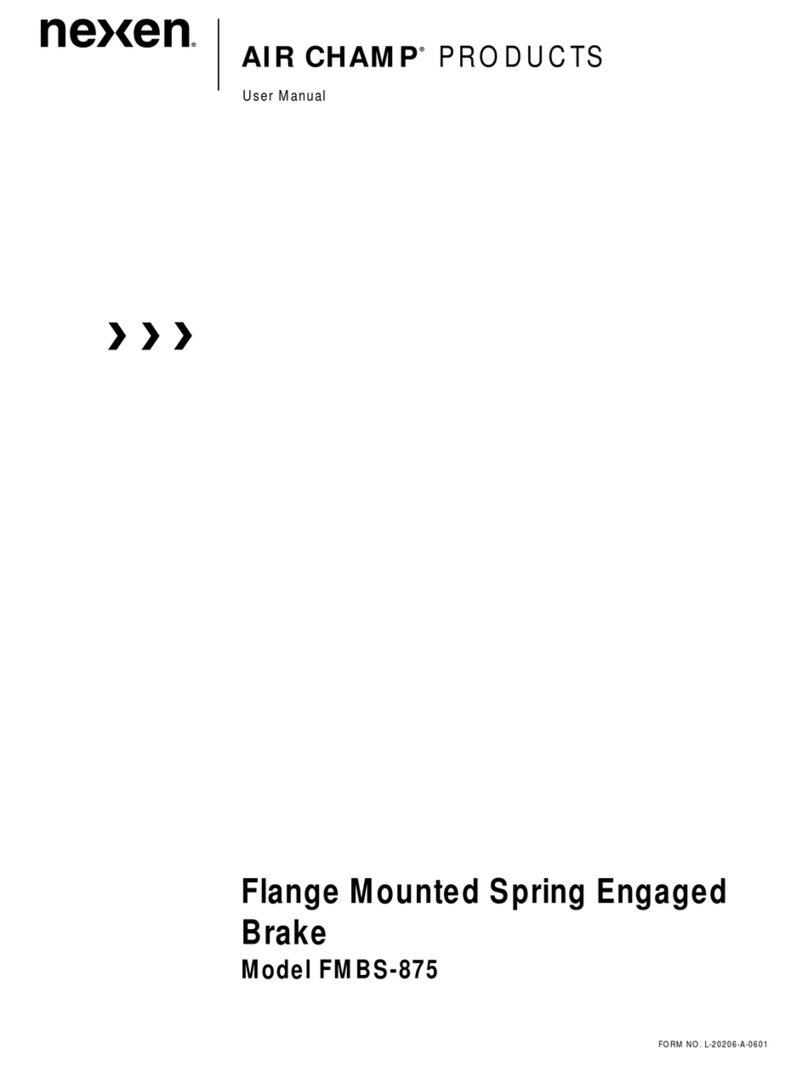
Nexen
Nexen AIR CHAMP FMBS-875 user manual
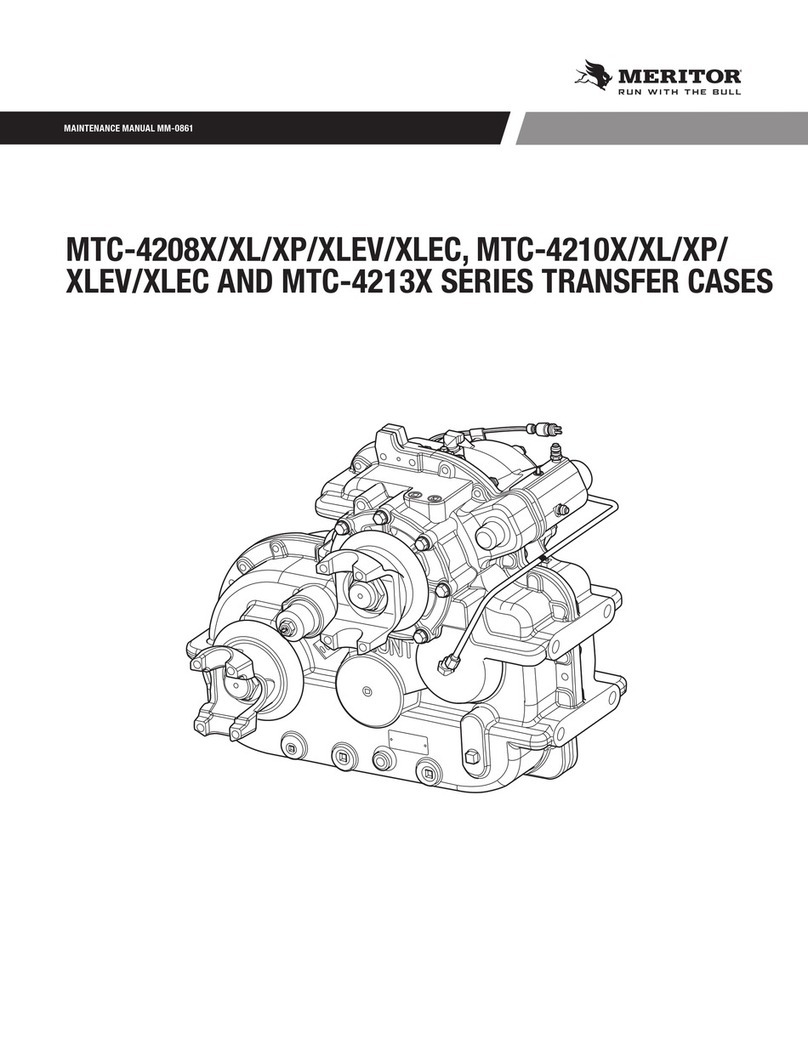
Meritor
Meritor MM-0861 Maintenance manual
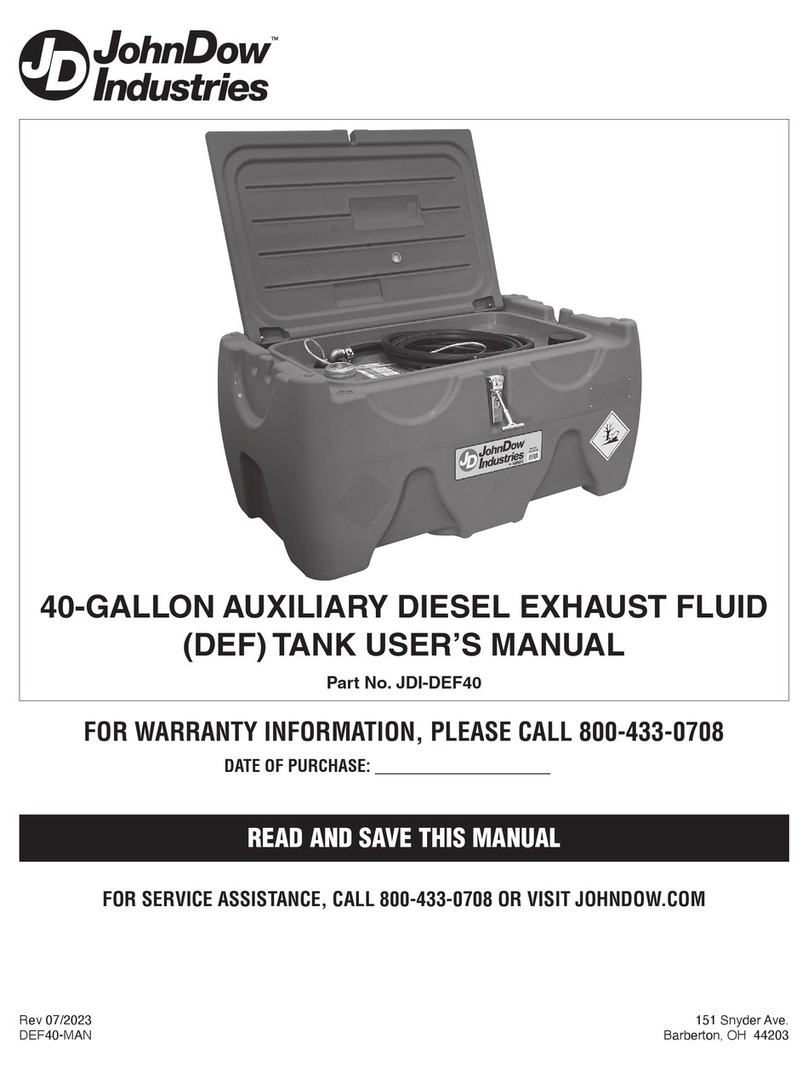
JohnDow Industries
JohnDow Industries JDI-DEF40 user manual

Tecnodue
Tecnodue I.T.S. ST 1200 operating manual
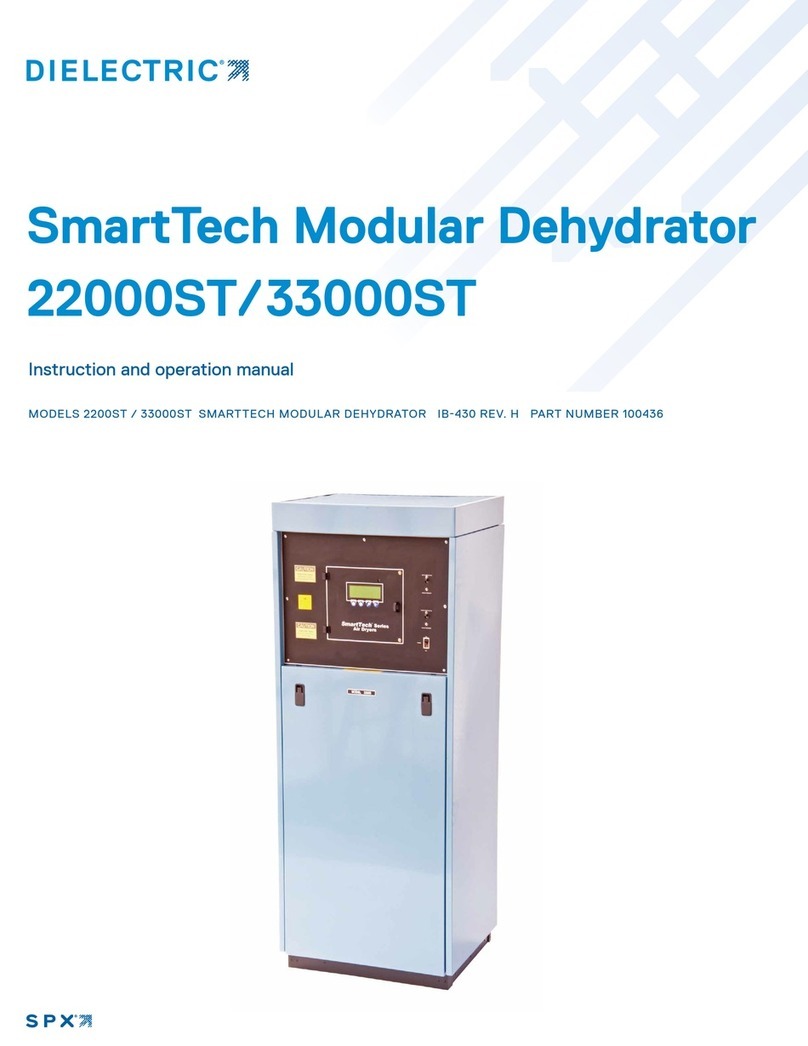
Dielectric
Dielectric 2200ST SmartTech Modular Dehydrator Instruction and operation manual

Datalogic
Datalogic SG-DM instruction manual
